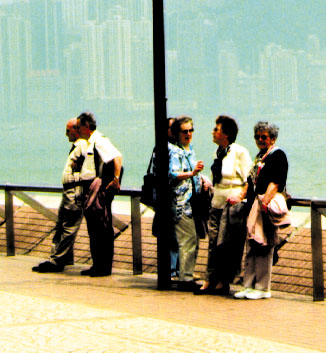 Pearl of
the Orient
Pearl of
the OrientHong Kong’s visitors travel in different ways



 Pearl of
the Orient
Pearl of
the Orient
Hong Kong’s visitors
travel in different ways
By Becky Chu and Teresa Fung
According to the statistics from the Hong Kong Tourist Association, more than 9.3 million tourists arrived at Hong Kong in 1994. The figure is 4.4 percent higher than that of the previous year.
Aside from joining tours, some tourists enjoy sightseeing on a self-help basis.
“I don’t like to join tours. I like to be on my own,” said Mr. Flo.
His view was shared by a French couple in their late 20s. They found it more efficient in planning the routes for self-helped trips.
“We felt free during the self-organized journeys,” one said.
Mr. Alan Addison, a tourist from Australia, agreed that he has more fun on a self-help trip. He said, “It’s much cheaper, and I can go wherever I like.”
Being alone on their journeys, however, self-helpers face some difficulties.
“I have to keep an eye on my belongings at every moment,” Mr. Addison said. “Besides, wasting much time on booking air tickets and hostels is another headache to me.”
Sightseeing is an indispensable part of the programme. The Peak, Ocean Park, and the Sung Dynasty Village, which are mentioned in tour guides published by the Hong Kong Tourist Association, are popular tourist spots.
While some tourists prefer wandering around individually, others choose to join the local tours organized by the association and various travel agencies.
Said a spokesperson of Hong Kong Tourist Association: “Hong Kong’s culture and heritage are shown in citizens’ daily lives. Therefore, short tours around Hong Kong introduce the essence of the city to the tourists.”
Labelled as a “shopping paradise”, Hong Kong has many shopping malls crowded with tourists.
Over the previous years, tourism has contributed to Hong Kong’s economic prosperity. In 1994, it brought $64.3 million to the Territory.
But making money is not so easy now.
An owner of an electronics shop in Tsim Sha Tsui said, “Business is getting worse. Affected by the global economic recession, the purchasing power of tourists has declined in recent years.”
To show Hong Kong’s traditions and lifestyles, and to attract more tourists, the Tourist Association has initiated various major festivals and events.
One of these is the Hong Kong Dragon Boat Festival. International races are organized annually on the water of Victoria Harbour off Tsim Sha Tsui East.
Apart from local activities, the association has organized “image-building” programmes overseas. For instance, the “Hong Kong Update” presentations were held in southern Europe, on the Iberian Peninsula and in the Middle East. These presentations not only publicize travel, but also elicit media coverage over Hong Kong.
According to the association’s statistics, tourists stay in the Territory an average of four days.
Despite the limited visiting time, many tourists are impressed by the different aspects of Hong Kong.
Apart from the scenery, the hustle and bustle attracts them.
“The prosperity in the commercial field and the quick pace here create an energetic atmosphere,” said an Englishman.
On top of this, Hong Kong’s handover of sovereignty has posed marked influence on some tourists’ choices of visit.
“I would like to seize the opportunity to come here before 1997,” said one German visitor. “After ’97, Hong Kong may lack democracy. Travelling here may become more difficult because of the complicated procedures involved.”
